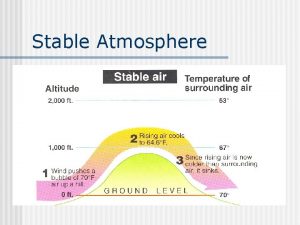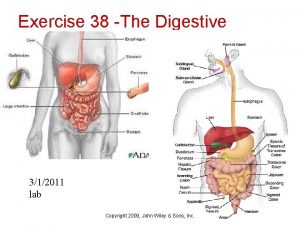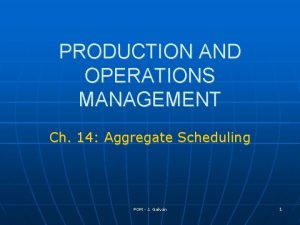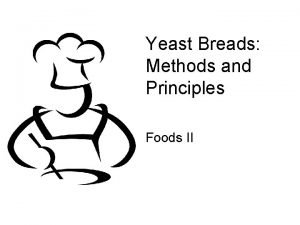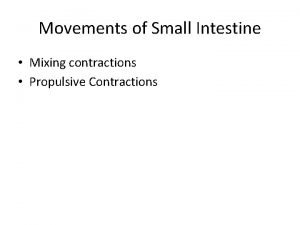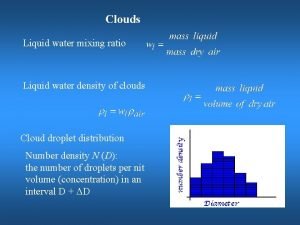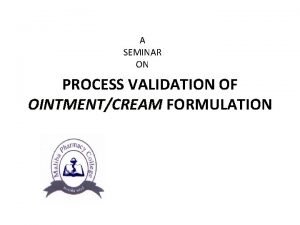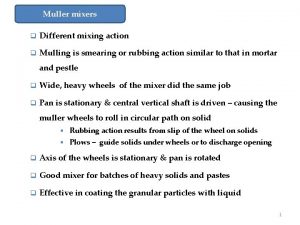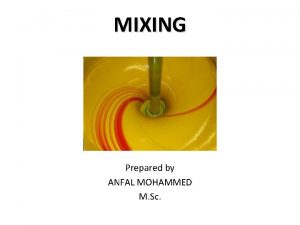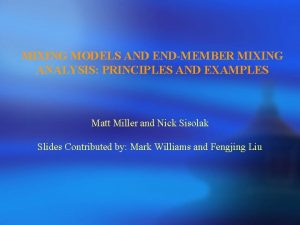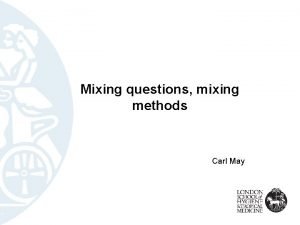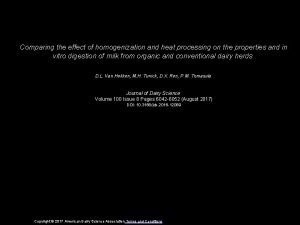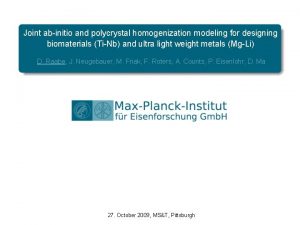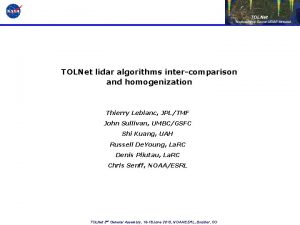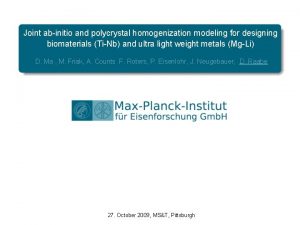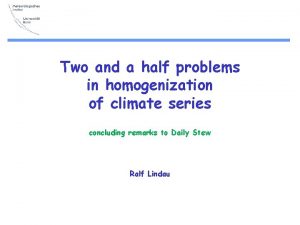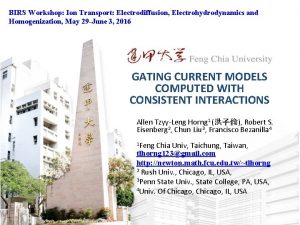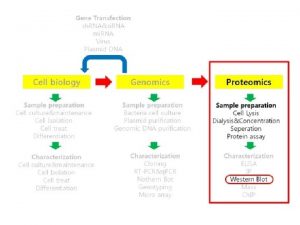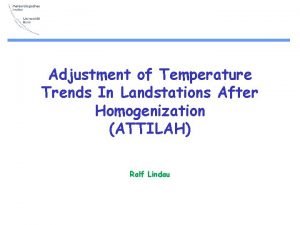Mixing and Homogenization Definition of mixing Mixing may
















































- Slides: 48

Mixing and Homogenization

Definition of mixing �Mixing may be defined as a unit operation in which two or more components, in an unmixed or partially mixed state, are treated so that each unit (particle, molecule etc. ) of the components lies as nearly as possible in contact with a unit of each of the other components.

Importance of mixing � 1. To make simple physical mixture In the production of tablets, capsules, sachets and dry powders two or more powders or granules are mixed.

� 2. Physical change Mixing may aim at producing a change that is physical, for example the solution of a soluble substance. In case of dissolving a solid in a solvent mixing will take place by diffusion but the process will be slow. In this case agitation makes the process rapid.

� 3. Dispersion In case of emulsions and creams two immiscible liquids are mixed where one liquid is dispersed into other. In suspension and pastes solid particles are dispersed in a liquid by mixing.

� 4. Promotion of reaction Mixing encourages and controls a chemical reaction, so ensuring uniform products

Objective of mixing � To ensure uniformity � To initiate or to enhance the physical or chemical reactions e. g. diffusion, dissolution etc. � To make the following products: o Tablets o Suspensions o Emulsions o Pastes o Creams o Ointments o Solutions o Syrups o Tablet coatings

TYPES OF MIXTURES AND ENERGY REQUIREMENTS There are 3 types of mixtures: ü positive mixtures: � Formed from materials such as, gases or miscible liquids. � The materials mix spontaneously and irreversibly by diffusion � No input of energy if time of mixing is unlimited, although time will be shorten if energy is supplied. � Generally, these materials do not show any problems during mixing.

ü § § a) b) c) negative mixtures: materials have the tendency to separate out from each other. Energy needs to be supplied to keep components adequately dispersed. Some separate faster, while for others, the separation is slower. For example, In a suspension, there is the dispersion of solid in the solution (fast separation) Emulsions, creams and viscous suspension have a slow separation. Are more difficult to be formed and require high degree of mixing efficiency.

ü Neutral mixtures: � Are static in behaviour � Neither mixing nor de-mixing occurs, unless acted upon by an external system of forces. � Examples are: a) Mixed powders b) Pastes.

Planetary Mixers � Planetary mixers are one of the most widely used mixers in the pharmaceutical industry. In the pharmaceutical industry, the planetary mixer is often used for basic operations of mixing, blending. This machine is also used in other industries like cosmetics and personal care products, food, glass, cements, ceramics, metal industry etc.

Planetary mixer

� The Planetary Mixer have two blades which rotate on their own axes, while they orbit the mix vessel on a common axis. � The blades continuously advance along the periphery of the vessel, removing material from the vessel wall and transporting it to the interior. � These mixers are ideal for mixing and viscous pastes.

Uses of Planetary Mixers � Planetary mixers are ideal for mixing of pharmaceutical creams, ointments, ceramics, color and pigments, resins, ink, cosmetic creams, herbal creams etc. � Planetary mixers are also ideal for mixing and kneading viscous pastes under atmospheric or vacuum conditions. � Used in the mixing of viscous, heat sensitive and cohesive pastes, dough and moist etc.

Applications of Planetary Mixers � Tablet Coatings � Tablet Granulations � Antacid Powder Blends � Collagen Solutions � Dental Composites

Advantages of Planetary Mixers � � � Ease of cleaning Ease of discharge Semi-continuous operation Capital cost Energy savings

SIGMA BLADE MIXER Ø Ø It is an example of agitator mixers. Its shape resemble the Greek letter sigma. It uses 2 mixer blades. Sigma blade mixer is a common form used to handle semi-solids of plastic consistency.

Ø Ø The two blades rotate towards each other and operate in a mixing vessel which has a double trough shape, each blade fitting into a trough. The two blades rotate at different speeds, one usually about twice the speed of the other, resulting in a lateral pulling of the material and divisions into two troughs, while the blade shape and difference in speed causes end-to-end movement


Ø Ø It works on the principle of shearing and convective in action. This mixer is designed for mixing, blending and kneading of medium and heavy onflowing pastes. The impellers and bowls are accurately machined to close tolerances, eliminating build up and providing high shear and rapid distribution of materials.

Uses of Sigma Blade Mixer � It is used for wet granulation process in the manufacture of tablets, in the production of ointments and pill masses. � This mixer is well suited to high viscosity materials like grease, putty, toffee and bubblegum. � With its strong construction and high power, the sigma blade mixer can handle the heaviest plastic materials and products like tablet granules, and ointments that are mixed readily. � It is used for solid-solid & liquid-solid mixing.

� It is available in working capacities of 5 litres to 2500 litres. � To reduce the entrainment of air in ointment masses the sigma mixer can be enclosed and operated under reduced pressure. This avoids entrainment of air and reduces decomposition of oxidisable materials but use it with caution if mixer contains volatile materials. � The vessel is covered for heating and cooling and the blades are hollowed. This is useful as some semi-solids may be reduced in viscosity by heating, while with other materials it may be necessary to dissipate the heat resulting from the energy put into the mixing process

Features � Available in mild or stainless steel � Available with hygienic finishes � Heating or cooling jackets optional

Advantages � Processes heavy pastes � No holdup of materials � Available with single or variable speed Disadvantages � It works at a fixed speed

Applications � Sigma blade mixer is used in chemical and pharmaceutical industries, to make food products, adhesives, rubber …

Homogenization � Pharmaceutical homogenizers are used to blend different kind of liquids uniformly, specially liquids having different properties. � Homogenizer actually reduces the size of particles of one material and dissolves it evenly throughout the other material. � Homogenization is defined as an intensive mixing of mutually insoluble phases to obtain a suspension or emulsion.

HOMOGENISATION OF EMULSIONS/SUSPENSIONS VALVE HOMOGENISER: q Used to modify the physical properties of a liquid or mixture by creating emulsions or dispersions. Construction ü consists of a valve, which controls the pressure on the feed. ü Impact rings help in size reduction

� Working 1) 2) 3) 4) 5) principle: The coarse emulsion is pumped between the valve and the seat at high pressure and high velocity. As the emulsion flows between the valve and the seat, pressure decreases and velocity increases Size reduction is enhanced by the collision with the metal surface of the impact rings. Turbulence occurs Emulsion is then discharged

� IMPROVEMENT: o o A two-stage homogenizer may be constructed. Emulsion is subjected to two valve systems. Single homogenizer may produce emulsion that, although small particle size, has a tendency to clump. Therefore, second homogenizer will break any clusters formed in the first stage.

� ADVANTAGE: ü No air is incorporated in the emulsion→ no contamination of emulsion. : the emulsifying agent gets adsorbed at the air-water boundary, causing denaturisation � DRAW-BACKS: ü Increase in temperature may decrease viscosity. ü There are some substances (ointment)which may fail to emulsify if subjected to very high temperature. ü Emulsion of this type should be first treated at high temperature, then at a lower temperature.

� Materials used: stainless steel is used so as to prevent contamination. Applications: q Dairy and food processing q chemical emulsions

Ultrasonic Homogenizers � Ultrasonic homogenizing is a mechanical process to reduce small particles in a liquid so that they become uniformly small and evenly distributed.

� Ultrasonic processors are used to reduce small particles in a liquid to improve uniformity and stability. These particles (disperse phase) can be either solids or liquids. A reduction in the mean diameter of the particles increases the number of individual particles. This leads to a reduction of the average particle distance and increases the particle surface area.

� There § § § are three main components of a laboratory Ultrasonic Homogenizer; An electronic generator which provides the power, A transducer which converts the signal to mechanical energy and A horn or probe where the processing takes place. The circuitry consists of a power rectifier, power switcher, a frequency conversion system, power amplifier, phase-locked frequency automatic tracking device, power regulator, power detector, power protector device and microcomputer controller.

Driven by the appropriate impedance and power, the transducer subassembly generates mechanical energy through a piezoelectric resonator which is focused and amplified with a tuned, titanium metal horn (probe). When the probe tip is immersed in sample solution, intense, high frequency sound waves coming from the tip of the probe induce cavitations. As the cavitations “bubbles” collapse, high shear forces break the material into smaller particles.


Machine Structure Front 1. Transducer cable 2. Sleeve (hand hold position) 3. Booster 4. Probe 5. Control panel 6. Housing 11. Power switch 12. Temp. detector 13.Protect knob Rear 7. Ultrasonic output connector 8. label 9. Fuse holder 10. Power socket


Advantages of Ultrasonic Homogenizing � Efficient for the reduction of soft and hard particles. � Low number of wetted and moving parts, this reduces frictional wear and cleaning time. � Exact control over the operational parameters influencing the cavitations.

Application � Emulsifications � Powders � Solutions � Suspensions

COLLOIDAL MILL � The principle of operation of the colloid mill is the passage of the mixed phases of an emulsion formula between a stator and a high speed rotor revolving at speeds of 2000 to 18, 000 rpm. � The clearance between the rotor and the stator is adjustable, usually from 0. 001 inch upward. � The emulsion mixture, while passing between the rotor and the stator, is subjected to a tremendous shearing action, which effects a fine dispersion of uniform size. � The shearing forces applied in the colloid mill usually raises the temperature within the emulsion.

� It ensures a breakdown of agglomerates or in the case of emulsions to produce droplets of fine size around 1 micron. � A coolant is used to absorb the excess heat. � Continuous mixing process is possible. � The material to be processed is fed by gravity to the hopper or pumped so as to pass between the rotor and stator elements where it is subjected to high shearing and hydraulic forces.

� The material is discharged through a hopper whereby it can be recirculated for a second pass. � Materials having higher solid and fibre contents conical grooved discs are preferred. � Cooling and heating arrangements are also provided in theses mills depending on the type of material being processed.



Uses of Inline Colloidal Mill � It is useful for milling, dispersing, homogenizing and breaking down of agglomerates in the manufacture of food pastes, emulsions, coatings, ointments, creams, pulps, grease, … � It is used to reduce the particle size of a solid in suspension in a liquid, or to reduce the droplet size of a liquid suspended in another liquid. � This is done by applying high levels of hydraulic shear to the process liquid. � It is frequently used to increase the stability of suspensions and emulsions. � It uses a high speed rotor to emulsify or disperse lotions, creams, sauces, and oils.

Advantages Very high shearing force can be generated. � Very fine particles can be prepared. � Particularly useful in preparing suspensions containing poorly wetted solids. � Useful for the preparation of relatively viscous emulsions. � Disadvantages � No wide application in solids � Wear of rotating plates � No fine grinding

THANK YOU
 Cultural homogenization pros and cons
Cultural homogenization pros and cons Cultural homogenization ap human geography
Cultural homogenization ap human geography Homogenization
Homogenization Hci patterns
Hci patterns Unstable air definition
Unstable air definition Propeller mixer definition
Propeller mixer definition Mixing of thymol and menthol
Mixing of thymol and menthol Cutting and mixing food items examples
Cutting and mixing food items examples Mixing red and green marbles physical change
Mixing red and green marbles physical change Mixing and dissolving
Mixing and dissolving Serves as a mixing chamber and holding reservoir
Serves as a mixing chamber and holding reservoir Soluble salts can be made by mixing acids and alkalis
Soluble salts can be made by mixing acids and alkalis Tools for mixing blending straining and rolling
Tools for mixing blending straining and rolling Jingles are the message written around the brand
Jingles are the message written around the brand Code mixing and code switching
Code mixing and code switching Counterseasonal product and service mixing
Counterseasonal product and service mixing Mixing time
Mixing time Break-bulk, consolidation and postponement are functions of
Break-bulk, consolidation and postponement are functions of Ramco super plaster mixing ratio
Ramco super plaster mixing ratio What are the nutritional contributions of yeast breads
What are the nutritional contributions of yeast breads Single use mixing
Single use mixing Herbicide mixing cheat sheet
Herbicide mixing cheat sheet Peristaltic contraction
Peristaltic contraction Mixing studies
Mixing studies Mixing studies table
Mixing studies table What is a mixing study
What is a mixing study Vertical mixing of air
Vertical mixing of air Water mixing ratio
Water mixing ratio Magma mixing
Magma mixing Examples of code mixing
Examples of code mixing Characteristic of magma
Characteristic of magma Additive synthesis color
Additive synthesis color Mixing time
Mixing time Water vapor mixing ratio
Water vapor mixing ratio Bezold effect
Bezold effect Total flow calculation magic box
Total flow calculation magic box Baking cookies chemical or physical change
Baking cookies chemical or physical change Mulling mixer
Mulling mixer Hybridization of formaldehyde
Hybridization of formaldehyde Types of glass ionomer cement
Types of glass ionomer cement Series shunt feedback
Series shunt feedback Diffie hellman color mixing
Diffie hellman color mixing Mixing method for cookies
Mixing method for cookies Conservative mixing
Conservative mixing During chemical dehumidification process of air
During chemical dehumidification process of air Benzeri
Benzeri A worker mixing chemicals must not wear
A worker mixing chemicals must not wear Merits of double cone blender
Merits of double cone blender End member mixing analysis
End member mixing analysis




